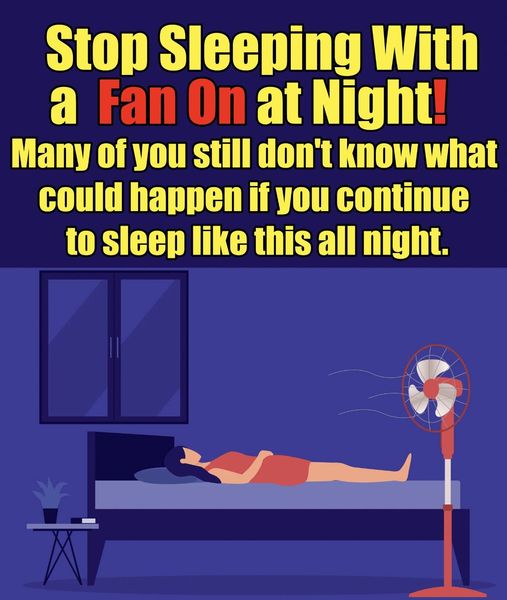Many people rely on fans to stay cool while sleeping, but did you know that using one at night can actually disrupt your sleep? While fans may seem like a simple solution to regulate temperature, they don’t always provide the rest you need for a good night’s sleep. Let’s explore why using a fan at night can impact your sleep quality and how to create a better sleep environment.
The Impact of Temperature on Sleep
Temperature plays a crucial role in the quality of our sleep. Experts agree that the ideal room temperature for sleep is between 60 to 67°F (15 to 19°C). When the temperature aligns with your body’s natural cooling process, it helps your body prepare for deep, restorative sleep. This is because your body naturally lowers its core temperature before sleep and increases it as you wake up.
However, when the room is too hot or too cold, it can interfere with this process and prevent you from falling into the deep, restful sleep your body needs. Overheating can make it difficult to sleep, while being too cold can cause muscle contraction, leading to fragmented sleep as your body works to stay warm.
Why a Fan Might Not Help
Fans are often used to move air around the room, especially in warmer weather. However, they don’t actually lower the room temperature, which is crucial for achieving quality sleep. If the room is already warm, a fan might only circulate hot air, making it harder for your body to cool down properly. In this case, the fan can cause you to overheat, waking you up sweating in the middle of the night.
On the other hand, if the room is cool, a fan blowing air directly onto you might cause you to feel chilled. This drop in temperature can disrupt your sleep, as your body might have difficulty regulating its temperature while you’re in deep sleep or REM sleep, making it harder to stay asleep through the night.
 Tired mother / Credit: Shutterstock
Tired mother / Credit: Shutterstock
The Role of Melatonin in Sleep
Melatonin is a hormone that regulates your sleep-wake cycle. It’s produced when your body is ready to sleep, and cooler environments encourage melatonin production. A room that is too warm, however, can inhibit melatonin release, making it harder for you to fall asleep.
If you’re using a fan, the airflow could either be too cold or too warm, both of which can affect your body’s ability to regulate temperature and produce melatonin. This can prevent you from entering deeper stages of sleep, which are essential for physical and mental rejuvenation.
Tips for Better Sleep Without a Fan
If you’ve been relying on a fan to regulate your sleep environment, there are several other ways to improve your sleep without disrupting your body’s natural temperature regulation.
- Bedding and Blankets: Choose breathable materials like cotton or linen for your bedding. These fabrics allow air to circulate and prevent you from overheating during the night. Avoid heavy or synthetic materials like polyester, which can trap heat and moisture.
- Invest in a Cooling Mattress: Certain mattresses, like those with cooling gel layers, promote airflow and prevent heat retention. Memory foam mattresses are known for trapping heat, so investing in a mattress designed for optimal temperature regulation can help improve your sleep quality.
- Wear Lightweight Sleepwear: The type of clothing you wear to bed can also impact your body temperature. Opt for breathable fabrics like cotton or moisture-wicking materials that help maintain a comfortable sleep temperature.
- Humidifiers or Purifiers: If you use a fan for white noise or to maintain humidity levels, consider using a humidifier or air purifier. These devices can add moisture to the air, helping to prevent dryness and dehydration, and they are often quieter than fans.
- White Noise Machines: If you rely on the sound of a fan to help you sleep, consider using a white noise machine instead. These devices produce calming sounds, such as rain or ocean waves, that create a peaceful environment conducive to sleep.
Sleep Better by Creating the Right Environment
Good sleep isn’t just about the number of hours you spend in bed—it’s about the quality of your rest. By optimizing your sleep environment, including the room’s temperature, bedding, and the sounds around you, you can improve your chances of getting a deep, rejuvenating night’s sleep.
Next time you reach for a fan, consider whether it’s truly helping or harming your sleep. By making a few changes to your routine and environment, you can ensure a better night’s rest.
For further reading on sleep-related topics, check out these articles:
Full Story: Man Loses 360 Pounds Naturally—Internet Rallies to Support His Next Step
Full Story: Tammy Hembrow’s Bikini Photos Stirring Controversy—Here’s Why Everyone’s Talking
By adjusting your sleep environment and understanding the effects of temperature on your body, you can improve your sleep quality and wake up feeling refreshed and recharged.



